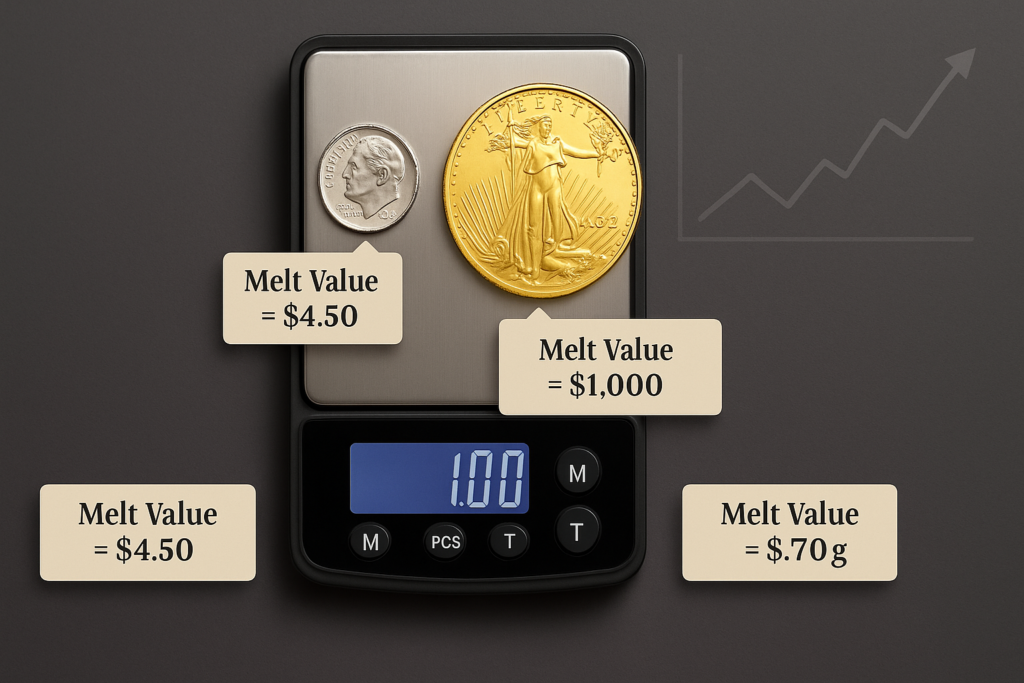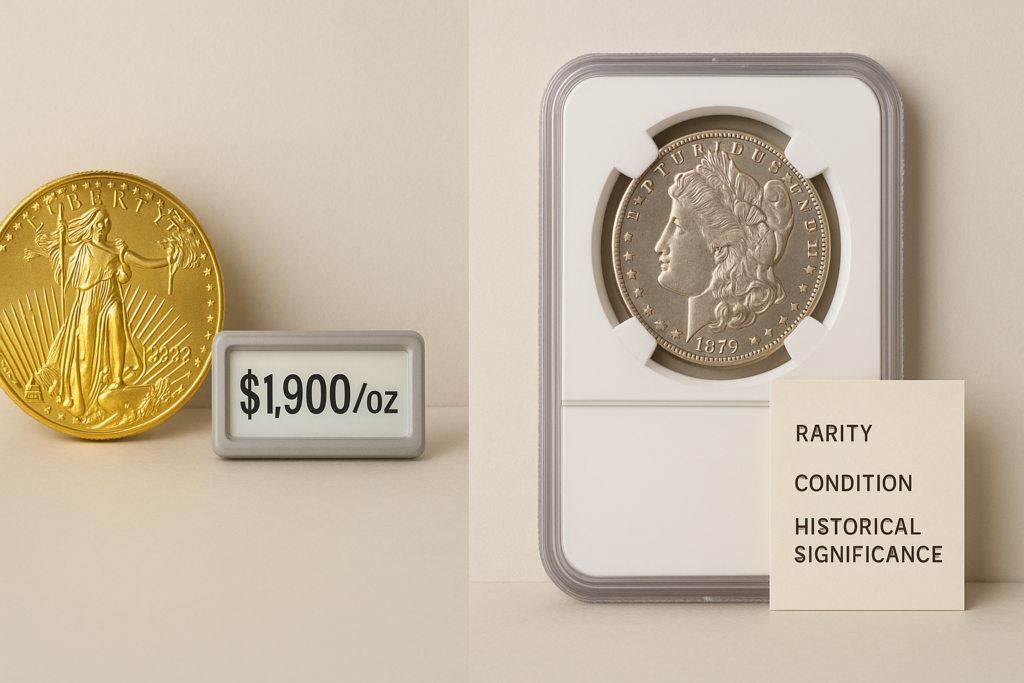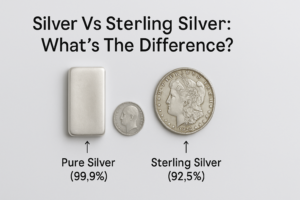The melt value of a coin is something seasoned precious metals investors know well, but coin collectors often find it less interesting. Collectors usually care more about a coin’s art, history, and rarity than its metal content.
Still, understanding a coin’s metal value can help you better appreciate its beauty, significance, and scarcity. The good news? It’s easier to learn than you might think.
In this article, you’ll discover what melt value really means, how to calculate it, how it differs from spot value, and why it matters.
Let’s dive in!
Defining ‘Melt Value’ Of Coinage

Melt value is simply the spot/ current price of a coin’s actual metal content.
Coin values can vary depending on several factors. Coins have melt value and numismatic value. For coin collectors, coins have a numismatic value. The worth of the metals that coins contain is their melt value.
Coins can be valued because of their collectibility, because of the metals they contain, or both. The melt value of a coin is also known as ‘intrinsic value.
‘ Here’s an example of melt value –
For instance, the intrinsic worth of a 1-oz gold coin would be determined by the amount of gold it contains based on the current spot price. If the price of gold is $1,000 per ounce and the coin has an exact weight of one troy ounce of pure gold in it, its intrinsic value is $1,000 in this case, regardless of the coin’s face value/ denomination.
A coin is more likely to be removed from circulation when its intrinsic value hugely exceeds its face value.
The Importance Of Knowing The Melt Value Of Coins For A Collector
Knowing how much a coin is worth involves expertise, experience, and knowledge. But there are certain benefits as well –
You can determine the precise premium you’re paying. For instance, if you purchase a 1 oz. Gold Maple Leaf for a competitive $1,397 and you know the melt value of that gold ounce is $1,245 – this enables you to monitor that your coin dealer does not indulge in price gouging, as well as the monetary worth assigned to the Maple Leaf’s aesthetic value, mintage, and historical significance.
This enables numismatists to decide how to allocate their financial resources for collecting in an informed and rational way. A collector has an advantage when purchasing coins because they are informed on coin melt values.
The Calculation Of A Coin’s Melt Value
The amount of metal present within an asset determines its melt value. To account for this, the metal content of each coin is multiplied by the metal’s spot price to determine its melt value. To calculate this, we would write an equation like this –
Melt value = mass of a particular metal in the coin × spot price of that metal.
How Does The Melt Value Of A Coin Differ From Its Numismatic Value?
Coins made of valuable metals may or may not have numismatic value, but according to how much precious metals they contain, they will always have intrinsic value. For instance, the 90% silver content of certain American coins, such as the dime, nickel, and half-dollar, from before 1964 gives them a melt value.

Knowing the purpose of a coin is crucial when thinking about buying one. A coin collector with an interest in coin history is ready to make investments that are more based on numismatic value. A person is more likely to choose coins with the lowest numismatic value if they are buying coins as a significant component of their investments and savings.
Now that you have a good understanding of coins’ melt value and numismatic value, let’s discuss the factors involved in distinguishing between them.
The rarity, significance, and condition of the coin all play a role in this difference.
1. Rarity
The rarity of a coin is the primary factor determining its numismatic value.
A limited edition with low mintage numbers intended to increase scarcity is an example of how rarity can be purposefully generated. However, rarity can also be mistakenly generated, such as when coins are issued unintentionally or there are minting errors.
Additionally, rarity is brought on by aging-related waste. Even coins that were initially produced in the millions progressively deteriorate, get lost, and eventually become rare metals.
As for coins primarily bought for their metal content (melt value), such as bullions or junk silver coins, rarity doesn’t add much value to their desirability.
2. Condition
The second most crucial factor in determining a coin’s numismatic value is its condition. Mints might go above and beyond to create special edition coins of the highest caliber for the collectors’ market. To maintain their quality, these are frequently then sealed and left untouched.
Many coin collectors send their coins for grading to verify their condition because even some excellent mint-state specimens of ordinary currency coins can fetch significant sums.
In cases of melt value, the condition of a coin doesn’t come into play. A pristine condition gold bullion coin wouldn’t cost significantly higher than an average condition one of the same. Yes, you may get slightly more (it’s called ‘premium’ and we’ll get into that shortly) for a better condition and other factors I’m discussing here, but not as much as it would be in the case of a collectible or numismatic coin.
3. Collectability/ Aesthetics
The other qualities stated can combine to form collectability, which is a rather subjective factor. Some coins are far more aesthetically pleasing than others, making them more collectible.
For instance, it is generally agreed that the UK Sovereign, with its classic and traditional reverse design created by Benedetto Pistrucci, is a lovely coin. The silver Maria Theresa Thaler from the Austrian Mint is another coin that has increased collectibility due to its visually beautiful appearance.
This collectability factor isn’t much bothered about when you’re purchasing a coin solely for its metal content.
4. Historical Significance
Coins’ numismatic value may also increase due to their historical significance. To commemorate important occasions, numerous commemorative coinages have been produced for ages.
Coins comprising both common currency and precious metals are included in this. One example – coins worth 50p and £2 are frequently released in the UK to commemorate important national events.
Some numismatists build their collections on certain themes. Therefore, the historical significance of an event may greatly increase a coin’s numismatic value.
The historical significance of a coin only relates to its numismatic value and overall collectability rather than the melt value of its metal content.
Understanding Numismatic Premium
The premium is essentially what raises the value of a coin over the same amount of precious metals in other forms. This added value combines historical, monetary, artistic, and speculative elements. The amount of the premium fluctuates for every single type of coinage and year separately, unlike gold or silver, which has a fixed price.
Another aspect that sets the premium cost apart from the cost of precious metals is that, while it can change depending on the price of the metal, the premium typically changes regardless of the market price of the metal used to make the coin. The rationale is that compared to a raw resource, uniqueness and sentimental value are more sensitive to changes.
Fundamentally, the premium is nothing more than the expression of the difference between the demand and supply of a specific coin model. Any manufacturer, even the Paris Mint, is entirely free to choose whether to offer a coin for the price of a particular metal or the double. As long as customers exist, it is possible to wager that a nice test or limited edition will have some sort of value.
I advise you to exercise extreme caution while placing a wager on a coin’s premium because it can change at random. And the possibility of not receiving this additional when you sell it is considerable.
Although the term “premium” technically applies to precious metals bullion as well, we prefer “manufacturing” or “cost of making” instead. Additionally, the pricing of ingots is substantially lower than the price of coins – the percentages range from 0.5% to 2% and 3-30%, respectively.
You can also discuss the numismatic value of vintage bars from a symbolic period, for instance, the gold rush, which will sell for more than the price of their pure gold, or some exquisite nuggets. But this is very rare.
Conclusion
I hope this article has been able to explain the melt value of coins and its difference from the numismatic value to you in the simplest possible manner. This will assist you in being better informed and having clarity of thoughts while deciding what you want and what to buy.
Frequently Asked Questions Related To The Melt Value Of Coins:
What Is The Difference Between Melt Value And Spot Price?
Coin melt value and coin spot price are different in that – melt value depends on how much of a specific metal is present in an item. Because of this, a coin’s melt value is determined by multiplying the metal content by the metal’s current price.
So, to simplify –
- Spot Price: Current price of any metal (without premiums)
- Melt Value: Spot Price x Mass of the metal in that coin
The spot price of a particular coin as a whole, on the other hand, is a different concept from the spot price of the coin’s metal content. A coin’s spot price, or as more commonly known, current market price, includes aspects like premium or cost of making, etc, in addition to the melt value of that coin.
Is It Worth Melting Down Silver Coins?
This is really a very arbitrary topic. My short answer is – No.
It’s most likely not worth it.
Coins usually have a higher numismatic value than their melt value. In terms of the costs associated with the actual melting process, this is particularly true.
However, everything is dependent on the metal’s current price and whether or not it is sufficient to justify the melting. A bulk lot of older coins can have more worth in silver than you paid for it. If this is the case, you are quite fortunate. Regardless, you may simply sell those as silver coins and skip the melting process, which obviously costs you both time and materials.
What Coins Are Worth More Melted Down?
The pennies and nickels you use in everyday transactions are now worth more when melted down due to higher metal prices. For example, prior to 1992, 1p and 2p coinages were 97% copper. Due to the skyrocketing price of copper in 2006, these coins were worth more as scraps than their respective face value.
But take note – it is forbidden to melt down realm coins.

![You are currently viewing What Does Melt Value Of Coins Mean? [Learn About The Numismatic Value Too]](https://coincollectorium.com/wp-content/uploads/2025/06/ChatGPT-Image-Jun-20-2025-12_52_40-AM.png)
![Read more about the article A Complete Guide To Coin Storage [Best Home Storage Ideas & Beyond]](https://coincollectorium.com/wp-content/uploads/2023/09/Untitled-design-300x169.png)
